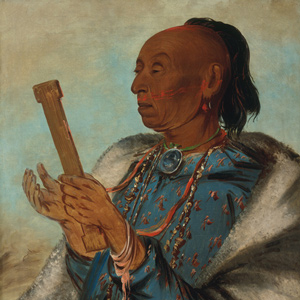While hunting on the Missouri River below present Williston, North Dakota, Lewis is accidentally shot through the flesh of his buttocks. The next day, they catch up to Clark‘s group at Reunion Bay. As one united force, they are ready to sprint down the river to St. Louis.
At the Knife River Villages, they drop off the Charbonneau family and pick up Chief Sheheke and interpreter René Jusseaume who will visit Washington City.
The faithful paddlers meet several traders and receive flour, whiskey, woven shirts, and most importantly, news of the United States.
On 23 September 1806, the citizens of St. Louis—having given them up for dead—provide a boisterous welcome. The captains commence writing.
The Kickapoos
Always on the move
by Kristopher K. Townsend
Perhaps more than any North American people, the Kickapoo exemplify the transitory nature of the native nations encountered during the Lewis and Clark Expedition. In 1803, there was at least one village near Ste. Genevieve on the Mississippi River.
The Cheyennes
by Kristopher K. Townsend
Many, including the expedition members, misheard the people’s name as ‘chien’—French for ‘dog’. Their name actually comes from the Sioux exonym shahíyena, perhaps meaning ‘people of alien speech’. The captains thought that they might make good trading partners.
The Arikaras
by Kristopher K. Townsend
Spelled variously in the expedition journals, Clark sometimes called the Arikara people Pawnee due to their similar linguistic origins—both were Caddoan-speaking people. Weakened by smallpox and Sioux attacks, they would have significant impact on American fur trade interests on the Upper Missouri and affect the lives of several expedition members.
The Omahas
by Kristopher K. Townsend
The captains appeared eager to meet with the Omaha. They tried to find them at their two biggest villages and planted a flag at the gravesite of the chief who for many years had controlled trade in the region, the infamous Blackbird.
The Mandans
by Kristopher K. Townsend
After the 1781 smallpox epidemic, the Mandan had moved into to a more defensible position in two villages immediately south of the Hidatsa at the Knife River. The Mandan-Hidatsa alliance had developed many years prior, and the two tribes previously shared their large hunting territory to the west.
The Hidatsas
by Kristopher K. Townsend
Prior to the expedition, the Hidatsa had settled in three villages just north of two Mandan villages in a complex now called the Knife River Villages. There, they practiced horticulture and hunting in the manner of the Plains Village tradition.
The Lakotas
by Kristopher K. Townsend
Presently known as the Lakota people, Lewis and Clark most often called them the Tetons. There were three main groups: Oglala, Brule, and Saone. The bands typically lived separately, hunted freely within each other’s territory, and came together for community events.
The Yankton Sioux
by Kristopher K. Townsend
The Yankton along with the Yanktonai make up the Western Dakota division of the Dakota People. Although the Yankton and Yanktonai sometimes considered themselves to be one people, their separate locations resulted in a unique history for each.
Synopsis Part 5
Fort Clatsop to St. Louis
by Harry W. Fritz
On 23 March 1806, once again battling the rising spring runoff, as it had each of the two previous years on the Missouri, the Corps of Discovery started up the Columbia River towards home.
Lewis’s Hunting Accident
Lewis's closest call
by Joseph A. Mussulman
The most serious hunting mishap, and surely the most memorable episode in Lewis’s frequently referenced “chapter of accedents,” was the moment on 11 August 1806 when Pierre Cruzatte shot him in the buttocks.
Reunion
Lewis and Pryor catch up
by Joseph A. Mussulman
After splitting up into five separate details over five weeks earlier, all the members of the Corps of Discovery were finally reunited 142 miles downriver from the mouth of the Yellowstone.
The Last Dance
What happened to the fiddle?
by Joseph A. Mussulman
On 8 June 1806, Meriwether Lewis wrote of that evening, “we had the violin played, and [we] danced for the amusement of ourselves and the Indians.” Presumably, Pierre Cruzatte was the fiddler. It was the last mention Cruzatte’s playing the violin. Why?
St. Louis by Air
The western gate
by Joseph A. Mussulman
The expedition arrived on 7 December 1803, witnessed the transfer of Louisiana from Spain to the United States, and metaphorically passed through its western gate on 14 May 1804. They would not return until 23 September 1806.
The Eighteen Toasts
Celebrating their return
by James P. Ronda
Two days after returning to St. Louis, its citizens celebrated the expedition’s return with a grand dinner and ball. Here are the eighteen toasts as reported in the Kentucky Western World.
Experience the Lewis and Clark Trail
The Lewis and Clark Trail Experience—our sister site at lewisandclark.travel—connects the world to people and places on the Lewis and Clark Trail.
Discover More
- The Lewis and Clark Expedition: Day by Day by Gary E. Moulton (University of Nebraska Press, 2018). The story in prose, 14 May 1804–23 September 1806.
- The Lewis and Clark Journals: An American Epic of Discovery (abridged) by Gary E. Moulton (University of Nebraska Press, 2003). Selected journal excerpts, 14 May 1804–23 September 1806.
- The Lewis and Clark Journals. by Gary E. Moulton (University of Nebraska Press, 1983–2001). The complete story in 13 volumes.


